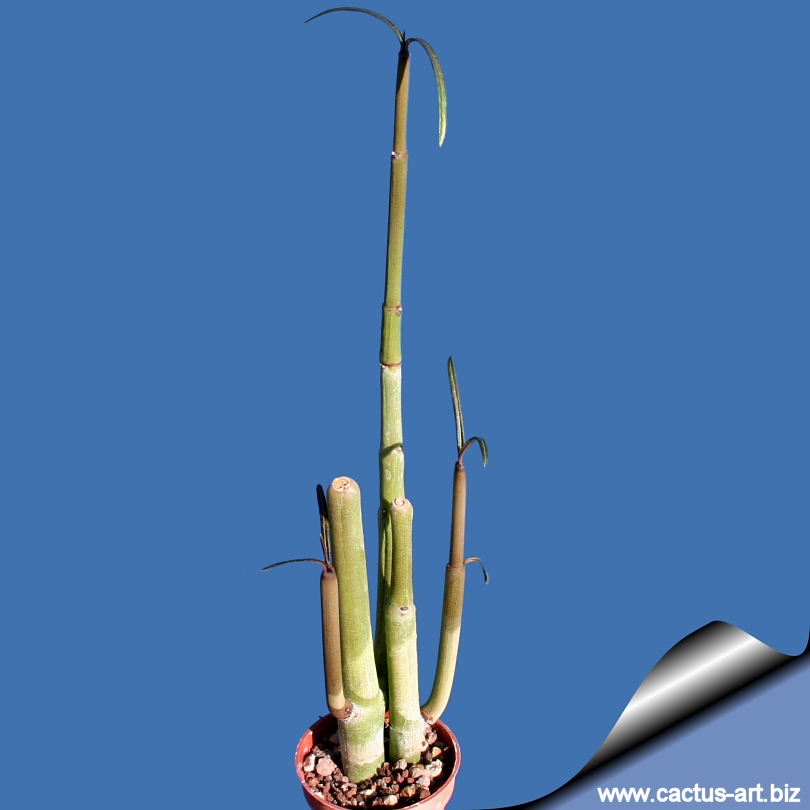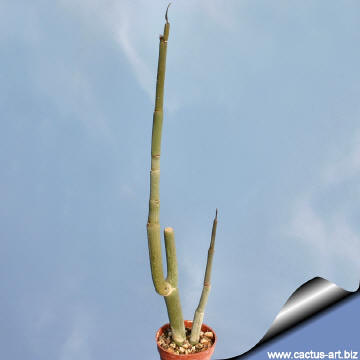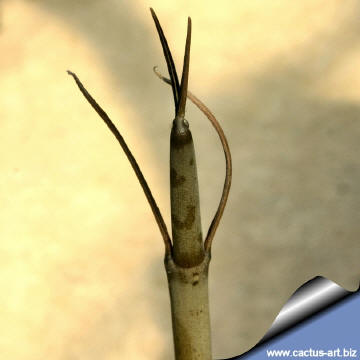|
|
|

An interesting odd looking succulent, smooth
with some constrictions which make it look like a row of small long
sausages, the strangely beautiful flowers tip it to the positive side.
|
 |
 |
|
Photo of conspecific taxa, varieties, forms and
cultivars of Ceropegia dichotoma.
Advertising
|
|
|
|
|
|
|
Family:
Asclepiadaceae (Apocynaceae) (Milkweeds family)
Scientific name:
Ceropegia dichotoma Haworth
In: Synops. Pl. Succ. 1812
Origin:
Endemic
to the Canary Islands archipelago. Tenerife (in the East: Anaga region,
e.g. in the ridge above Faro de Anaga and on the West parts: Teno
region, e.g. Barranco de los Cochinos), La Palma, La Gomera, Hierro,
Lanzarote)
Habitat: Growing abundantly in nature in
the Tabaibal-Cardonal zone at up to about 600 m altitude where it forms
large upright open
shrubs. It is found preferably on white or cream-colored older
grainy soils or rock crevices with good drainage, in sun exposed spots
and prolonged dry climate
Common Names include: (Spanish)
Cardoncillo
Synonyms:
- Ceropegia aphylla Link 1820 (nom.
Illeg. Art. 53.1)
- Ceropegia hians Sventenius 1960
- Ceropegia ians var. striata
Sventenius 1960
|
|
|
Description: It is the most succulent shrubby Ceropegia
related to
C.
fusca and probably to C. rupicola. It starts
as a single, firm, ascending stick, that in time makes a whole colony of
basally branched succulent stems, covered with white wax under sunny
conditions.
Adult
specimens look something like grey organ pipes.
Stems: Highly succulent, smooth with some constrictions which
make them look like a row of small long sausages, 30-120 cm tall (but
usually no higher than 60 centimetres and practically without leaves for
most of the year), mainly erect, partly prostrate or decumbent. Terete
5-20 mm in diameter, green, olive-green or light-brown to whitish-green
due to a wax layer.
Leaves: Sessile, linear-elliptic, 2-120 mm long, 3-8 mm wide
slightly succulent, green, vein paler, mergins revolute. Leaves appear
in the winter at each
node and on the tip of the
stem and are approx 5 cm long
arranged in opposite pairs, they are
deciduous and
wilt quickly if there isn't enough water.
Inflorescence: The inflorescence is a terminal (sometimes in
axillary) and almost sessile pseudo-umbels on upper stem section,
bearing 1-15 florets (But usually 2 to 6).
Flowers: Lantern-shaped, yellow. Corolla 3-4 cm long,
corolla tube 10-16 mm long, Corolla lobes, 5, yellow, narrowly
triangular, fused to form a conical to ovoid cage, they are
characteristically rolled outward, so that the windows are open wide.
Pedicel 2-6 mm long, Sepals triangular 1-2 mm long acute.
Blooming season: Autumn and winter.
Fruit: The fruit is a pair of large horn-shaped capsules up to 12
cm long.
|
|
Cultivation:
Full to
part sun, moderate water in warm season, drier in
winter. It requires hot conditions and how much sun as possible to
grow well. Can be grown outdoor in mild climate where it proves to grow
well semi-neglected. It is also very resistant and is very rare to see
an aphid or a sick part, be only aware of mealy bugs.


|
|